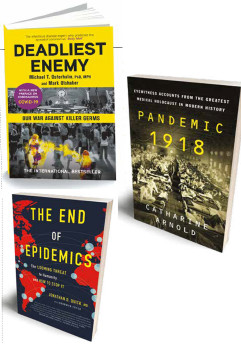DEADLIEST ENEMY: OUR WAR AGAINST KILLER GERMS
DEADLIEST ENEMY:
OUR WAR AGAINST KILLER GERMS
Unlike natural disasters, whose destruction is concentrated in a limited area over a period of days, and illnesses, which have devastating effects but are limited to individuals and their families, infectious diseases have the terrifying power to disrupt everyday life on a global scale, overwhelming public and private resources and bringing trade and transportation to a grinding halt.
In today’s world, it’s easier than ever before to move people, animals, and materials around the planet, but the same advances that make modern infrastructure so efficient have made epidemics and even pandemics nearly inevitable. And as outbreaks of COVID-19, Ebola, MERS, SARS, and Zika have demonstrated, we are woefully underprepared to deal with the fallout. So, what can - and must - we do in order to protect ourselves from mankind’s deadliest enemy?
Drawing on the latest medical science, case studies, policy research, and hard-earned epidemiological lessons, Deadliest Enemy: Our War Against Killer Germs explores the resources and programs we need to develop if we are to keep ourselves safe from infectious diseases. The authors, Michael T. Osterholm and Mark Olshaker, show how we could wake up to a reality in which many antibiotics no longer cure, bio-terror is a certainty, and the threat of a disastrous influenza or coronavirus pandemic looms ever larger.
The book was first published in March 2017 by Little, Brown Spark, but following the outbreak of the COVID- 19 pandemic, the book has been republished with a new preface touching the ongoing pandemic.
«Trying to stop an influenza-like transmission such as COVID-19 is like trying to stop the wind. At most, its spread was slowed by the near-draconian lockdown the Chinese government was able to impose on hundreds of millions of its citizens, as well as efforts by other countries to identify infected people and anyone they might have been in contact with. The only way the spread could have been curtailed was with an effective vaccine, which did not exist. Starting from scratch on such an undertaking requires many months or even years» the authors wrote in the new preface to the book.
«In any pandemic, effective leadership is critical, and the first responsibility of the president or the head of any nation is to offer accurate and up-to-date information, provided by public health experts, not agenda-oriented political operatives. It is far better to say we don’t know something but that we’re working on finding out than to offer a happy talk that may be contradicted by the next news cycle. If the president sacrifices his credibility, the public will not know where to turn. However, studies have repeatedly shown that if the public is given honest, forthright information, panic almost never ensues and we all learn to pull together» they stated.
The Center for Infectious Disease Research and Policy at the University of Minnesota (CIDRAP), stated on January 20, 2020, that COVID-19 would cause a pandemic, based on the clear transmission characteristics of the virus. About two months later, the World Health Organization (WHO) confirmed what CIDRAP predicted and declared COVID-19 a pandemic. Why did it take the World Health Organization (WHO) until March 11, to declare a global pandemic? We believe this led many leaders and organizations into a sense of complacency that there was still a good chance of containing the virus and became an unfortunate and unnecessary distraction from the vital planning process of how to mitigate and live with it. That kind of confusion and debate should make us realize we need a more effective way of evaluating when the world is at risk from a new deadly enemy. The first critical question we must confront is: How did we get into this crisis?
Moreover, the economics of modern healthcare dictates that most hospitals have extremely limited stockpiles of PPE, including respirators and N-95 respirator masks. «How will we respond if or when we can’t protect the healthcare personnel we’re depending on to treat all of the sick, who will easily overrun our already overburdened healthcare institutions? In a very real sense, what happens to our healthcare workers will be the historical metric of how we responded to this and future unfolding crises. In every case, if we don’t do all we can to protect them, they will quickly transition from providers to patients, further stressing already overburdened facilities» the authors warned, further advising that, «If we are serious about preventing this kind of threat in the future, governments must make an international commitment to spread out and diversify the production of critical pharmaceuticals, supplies, and equipment. We need to think of this in terms of the insurance model. Insurance companies don’t prevent disasters; they mitigate their impact».
In a time when shutdowns, cancellations, and quarantines become routine, the authors say, we must have the means to keep the manufacturing and distribution chains functioning for drugs and other vital products like needles, syringes, and even such basic items as saline bags.
«Not only do we need to develop more manufacturing capacity and redundancy of facilities around the world, but we have to invest heavily on the governmental level in new drugs and antibiotics for which no effective commercial business model exists. We cannot expect commercial pharmaceutical companies to invest billions of dollars in drugs that will be used only in emergencies.»
They also sound a wakeup call to policy and decisionmakers to make what they referred to as creative imagination whenever they are faced with any potential pandemic as this will help to come up with realistic plans in response to the threat. «We need creative imagination about what can and will happen and what we will need to be ready for when it does. This includes planning for continuity of operations in healthcare, government, and business. We need an international strategic stockpile of such things as critical lifesaving drugs and ventilators for patients, and personal protective equipment for healthcare workers. The United States should have its own similar stockpile with realistic quantities of the needed supplies—not the current grossly inadequate numbers we have available to fight the COVID-19 pandemic. And we need a robust plan for nearly immediate surge capacity at hospitals and clinics, such as setting up tents in parking lots so that patients suspected of the novel infection can be separated and, if necessary, isolated from the normal patient intake» they added.
With all of the illness, death, dislocation, and economic loss caused by the COVID-19 pandemic, the greatest tragedy would be if we «waste» this crisis by not learning from it and preparing for the future. If history is any guide, we will almost certainly be surprised by the specific microbe or strain that next threatens us with widespread infectious disease. But it will be to our own shame and at our own peril if we are not prepared to face it with all of the plans and resources that we already know we will need.
About the Authors
Dr. Michael Osterholm is Regents Professor, McKnight Presidential Endowed Chair in Public Health, and the founding director of the Center for Infectious Disease Research and Policy (CIDRAP) at the University of Minnesota. An internationally renowned epidemiologist, he has been at the forefront of public health preparedness, has led many outbreak investigations of international importance, and advises world leaders on the ever-growing list of microbial threats.
Mark Olshaker is an Emmy Award-winning documentary filmmaker and a New York Times #1 bestselling author of five novels and ten books of nonfiction. His books with FBI profiling pioneer John Douglas have sold millions of copies and offer a unique and intriguing perspective into behavioral science and criminal investigative analysis.
PANDEMIC 1918: THE STORY OF THE DEADLIEST INFLUENZA IN HISTORY
This book published in 2018 was authored by British journalist Catharine Arnold in memory of her grandparents Aubrey Gladwin and Lalage Bagley Gladwin, and the more than 50 million people who perished in the Spanish flu pandemic of 1918 to 1919. Arnold is best known for her London series of five popular history books, including: Underworld London: Crime and Punishment in the Capital City published in 2012.
The German soldiers termed it Blitzkatarrh, the British called it Flanders grippe, but globally the pandemic gained the notorious title of ‘Spanish flu’. Nowhere on earth escaped this common enemy: in Britain, 228,000 people died, in the United States of America it was 675,000, five times its total military fatalities in the World War I, while European deaths reached over two million. And yet at the time, governments suppressed news of the outbreak and the danger it posed for fear of impacting war-time morale. Even today, these figures are shocking to many – the war still hiding this terrifying menace in its shadow.
We find in this book that behind the numbers are human lives, stories of those who suffered and fought the pandemic – in the hospitals and laboratories. Arnold traces the course of the disease, its origins and progress, across the globe via these remarkable people. Some are well known to us, like former British Prime Minister David Lloyd George (1863-1945), former US President Woodrow Wilson (1856-1924), but many more are unknown. They are the doughboys from the US, gold miners in South Africa, schoolgirls in Great Britain and many others.
Publ ished 100 years after the most devastating pandemic in world history, Pandemic 1918: The Story of the Deadliest Influenza in History uses previously unpubl i shed records , memoirs, diar ies and government publications to uncover the human story of 1918. She writes: «Today, despite regular health scares about bird flu, SARS, HIV and Ebola, it is difficult to envisage a scenario in which something as common as inf luenza could cause widespread illness and death. Although most of us will contract influenza several times during our lifetimes, the influenza vaccination being only approximately 50 per cent effective, the majority will survive with a minimum amount of medical attention. What then was so different about Spanish flu and why did it have such a devastating impact?»
«To gain some understanding of these factors, we need to define the nature of influenza and consider a brief history of the disease. In general terms, influenza is a complex disease caused by an airborne virus which spreads between individuals in microscopic droplets, via coughing or sneezing. Bringing people together in close contact aids the spread of the infection, particularly in overcrowded communities such as schools, military camps and hospitals. In many cases, schoolchildren are the first to catch the virus and then transmit it to their families», she added.
THE END OF EPIDEMICS: THE LOOMING THREAT TO HUMANITY AND HOW TO STOP IT
Somewhere in nature, a killer virus is boiling up in the bloodstream of a bird, bat, monkey, or pig, preparing to jump into a human being. This not-yet-detected germ has the potential to wipe out millions of lives over a matter of weeks or months. That risk makes the threat posed by ISIS, a ground war, a massive climate event, or even the dropping of a nuclear bomb on a major city pale in comparison. Today, we see how the outbreak of the coronavirus disease has terrified the world and revealed how unprepared we are for the next outbreak of an infectious disease.
In The End of Epidemics: The Looming threat to Humanity and How to Stop It, published in January 2018, Duke Global Health Institute faculty member and past Chair of the Global Health Council Dr. Jonathan D. Quick examines the eradication of smallpox and devastating effects of influenza, AIDS, SARS, Ebola, and other viral diseases. He says: «We can end epidemics with seven sets of concrete actions proven over a century of epidemic response. The enormous health and financial impacts of epidemics are made worse through human foibles like fear, denial, panic, complacency, hubris, and self-interest.»
The seven action points that Dr. Quick proposes are coined in what he calls «The Power of Seven» to end epidemics before they can begin. These actions include: ensuring bold leadership at all levels, building resilient health systems, fortifying three lines of defense against disease (prevention, detection, and response), ensuring timely and accurate communication, investing in smart innovation, spending wisely to prevent disease before an epidemic strikes and mobilizing citizen activism.
He introduces the book by stating that, «Scientists don’t know which microbe it will be, where it will come from, or whether it will be transmitted through the air, by touch, through body fluids, or through a combination of routes, but they do know that epidemics behave a bit like earthquakes. Scientists know that a ‘big one’ is coming because scores of new, smaller earthquakes pop up around the g lobe e very y ear. S ome s ay t he n ext p andemic i s overdue. Thankfully, most epidemics are stopped in their tracks by public-health rapid-response teams.»
«Despite tremendous advances in science and public health, and our success fighting many epidemics, we have been unable to keep small outbreaks from erupting into something much more devastating. The obvious question is this: Why aren’t we deploying absolutely everything we have to make sure that the next disease outbreak doesn’t turn into a global catastrophe? The answer is depressingly simple. Rather than grappling with the threat directly, we hide behind our biases. Small infectious-disease outbreaks explode into global pandemics through human action or inaction. We human beings are too often victims of our own psychological, political, and sociological failures. Since the earliest times, the human failings delayed effective prevention and response» he says. This important work was co-authored by Bronwyn Fryer, a collaborative writer and a former senior editor for the Harvard Business Review.








